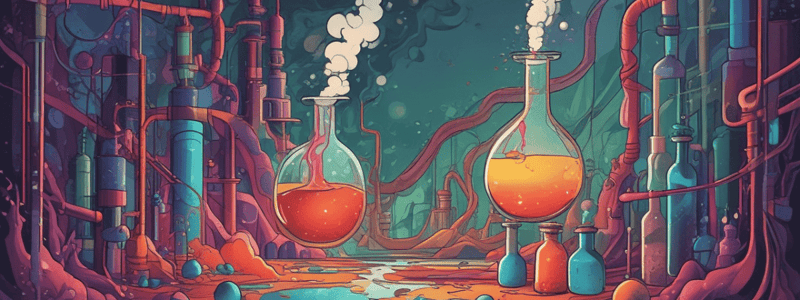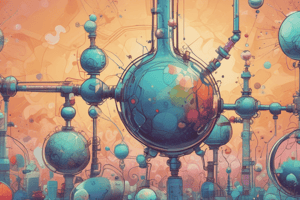Podcast
Questions and Answers
What is the name of the theory that involves the formation of an unstable intermediate between a reactant and a catalyst?
What is the name of the theory that involves the formation of an unstable intermediate between a reactant and a catalyst?
- Intermediate Formation Theory (correct)
- Activation Energy Theory
- Surface Adsorption Theory
- Collision Theory
In the reaction between nitrogen and hydrogen on the surface of an iron catalyst, what is the role of the catalyst surface?
In the reaction between nitrogen and hydrogen on the surface of an iron catalyst, what is the role of the catalyst surface?
- To provide active sites for the reaction (correct)
- To block the active sites
- To absorb the reactants
- To increase the activation energy
What is the term used to describe the accumulation of one substance at the surface of another?
What is the term used to describe the accumulation of one substance at the surface of another?
- Catalysis
- Adsorption (correct)
- Activation Energy
- Surface Area
What is the minimum energy required for a reaction to occur?
What is the minimum energy required for a reaction to occur?
What is the term used to describe the energy difference between the energy of products and reactants?
What is the term used to describe the energy difference between the energy of products and reactants?
What is the effect of increasing the surface area of a solid reactant on the rate of reaction?
What is the effect of increasing the surface area of a solid reactant on the rate of reaction?
What is the typical outcome of a reaction between an ionic and a covalent compound?
What is the typical outcome of a reaction between an ionic and a covalent compound?
What is the role of a catalyst in a chemical reaction?
What is the role of a catalyst in a chemical reaction?
Which type of catalysis involves a solid catalyst and liquid or gaseous reactants?
Which type of catalysis involves a solid catalyst and liquid or gaseous reactants?
What is the effect of autocatalysis on the reaction rate?
What is the effect of autocatalysis on the reaction rate?
What is the result of a decrease in activation energy in a reaction?
What is the result of a decrease in activation energy in a reaction?
What is the purpose of catalytic converters in car exhaust pipes?
What is the purpose of catalytic converters in car exhaust pipes?
What is the effect of an increase in temperature on the rate of a reaction?
What is the effect of an increase in temperature on the rate of a reaction?
What type of catalysis is an example of catalytic conversion?
What type of catalysis is an example of catalytic conversion?
What is the environmental benefit of catalytic conversion?
What is the environmental benefit of catalytic conversion?
Study Notes
Factors Affecting Rates of Reactions
- The rate of a reaction between a solid and a liquid can be increased by using a more finely divided solid, which increases the surface area available for reaction.
- The nature of the reactants can also affect the rate of reaction, with ionic compounds typically reacting faster than covalent compounds because their bonds break immediately in water.
Catalysis
- A catalyst is a substance that speeds up a chemical reaction without being chemically changed at the end of the reaction.
- There are three types of catalysis:
- Heterogeneous catalysis: the catalyst is in a different physical phase from the reactants, such as a solid catalyst with liquid or gaseous reactants.
- Homogeneous catalysis: the catalyst is in the same physical phase as the reactants.
- Autocatalysis: the product of a reaction becomes a catalyst for the same reaction, increasing the reaction rate as more product is formed.
Theories of Catalysis
- Intermediate formation theory: an unstable intermediate is formed between a reactant and the catalyst, which quickly breaks down to form the product, regenerating the catalyst.
- Surface adsorption theory: reactants diffuse onto the surface of a solid catalyst, where they react at an active site, and the products diffuse away, leaving the active site free for further reactions.
Activation Energy and Collision Theory
- Gas molecules are constantly moving and colliding, but most collisions are unsuccessful due to insufficient energy.
- The activation energy (Ea) is the minimum energy required for a reaction to occur, and only collisions with sufficient energy result in a reaction.
- A reaction profile diagram shows the energy profile of a reaction, including the activation energy and the heat of reaction (ΔH).
Effect of Catalyst on Activation Energy
- A catalyst provides an alternative reaction pathway with a lower activation energy, resulting in more successful collisions and an increased rate of reaction.
- The reaction profile diagram shows a lower activation energy with a catalyst, resulting in more successful collisions.
Influence of Temperature on Reaction Rate
- An increase in temperature results in faster-moving molecules, leading to more collisions and more effective collisions.
- The increase in temperature has a greater effect on the activation energy, making it more likely for collisions to be successful.
Real-World Applications of Catalysis
- Catalytic converters in car engines reduce pollutants such as carbon monoxide, nitrogen oxides, and unburned hydrocarbons by allowing them to react with each other and atmospheric oxygen.
- The environmental benefits of catalytic conversion include reduced NO emissions, less acid rain and smog, and improved air quality.
Studying That Suits You
Use AI to generate personalized quizzes and flashcards to suit your learning preferences.
Description
Explore the factors that influence the rate of chemical reactions, including the surface area of reactants and the nature of the reactants. Learn about catalysis and how catalysts speed up chemical reactions.



